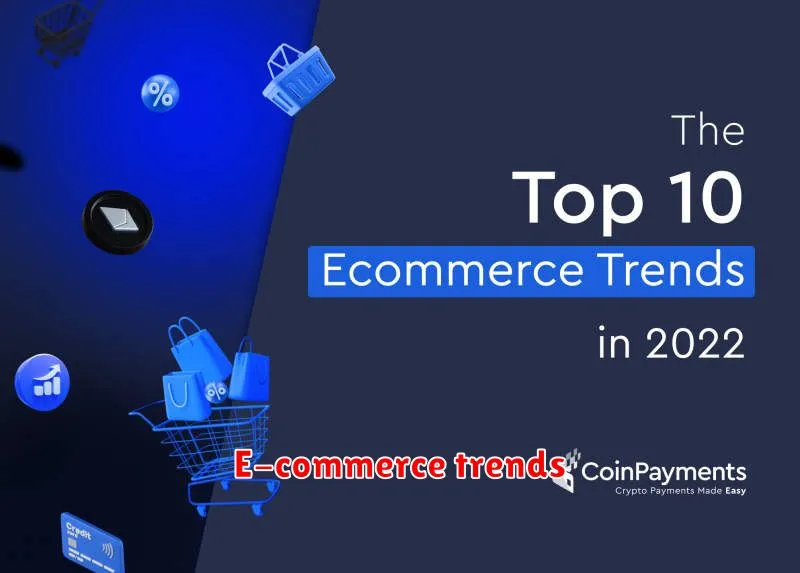In today’s fast-paced digital landscape, staying ahead of the curve is crucial for any e-commerce business. E-commerce technology is constantly evolving, offering new and innovative ways to engage customers, optimize operations, and drive sales. From artificial intelligence (AI) to augmented reality (AR), the possibilities are endless. By embracing these advancements, businesses can unlock a world of opportunities and gain a competitive edge.
In this article, we will delve into the latest e-commerce technology trends shaping the industry. We will explore how these technologies are transforming the customer experience, streamlining processes, and empowering businesses to thrive in the digital age. Join us as we navigate the exciting world of e-commerce innovation and discover how you can leverage these advancements to achieve your business goals.
The Evolving Landscape of E-commerce Technology
The e-commerce landscape is constantly evolving, driven by advancements in technology and changing consumer expectations. To stay competitive, businesses must stay ahead of the curve and embrace the latest trends. From artificial intelligence (AI) and machine learning (ML) to augmented reality (AR) and virtual reality (VR), innovative technologies are transforming the way businesses operate and interact with customers.
One of the most significant trends is the rise of personalization. AI and ML algorithms are enabling businesses to gather insights into customer behavior and preferences, allowing for tailored product recommendations, targeted marketing campaigns, and personalized shopping experiences. This level of customization enhances customer satisfaction and loyalty.
Another key development is the integration of voice commerce. With the growing popularity of voice assistants like Alexa and Google Assistant, consumers are increasingly using voice commands to make purchases. Businesses are adapting by optimizing their websites and mobile apps for voice search and integrating with voice assistants to provide a seamless shopping experience.
The emergence of headless commerce is also reshaping the e-commerce landscape. This architecture separates the front-end presentation layer from the back-end commerce platform, providing greater flexibility and customization. Businesses can choose the best front-end technology to suit their needs while utilizing a robust and scalable back-end for managing orders, inventory, and payments.
As technology continues to evolve, the e-commerce landscape will become even more dynamic. Businesses that embrace innovation and leverage the latest technologies will be well-positioned to thrive in this competitive environment. Staying informed about emerging trends and actively exploring new solutions is crucial for maintaining a competitive edge.
Top Trends Shaping the Future of E-commerce
The world of e-commerce is constantly evolving, with new technologies and trends emerging all the time. To stay ahead of the curve and thrive in this dynamic landscape, businesses need to be aware of the latest developments and how they can be leveraged to enhance customer experiences and drive growth. Here are some of the top trends shaping the future of e-commerce:
1. Artificial Intelligence (AI) and Machine Learning (ML): AI and ML are revolutionizing e-commerce by enabling personalized experiences, automated tasks, and data-driven insights. From intelligent chatbots and recommendation engines to fraud detection and inventory management, AI/ML is transforming how businesses operate and interact with customers.
2. Augmented and Virtual Reality (AR/VR): AR and VR are transforming the online shopping experience by allowing customers to visualize products in their own spaces and try them on virtually. This immersive technology enhances product discovery, reduces returns, and creates a more engaging and interactive shopping journey.
3. Voice Commerce: Voice assistants like Siri and Alexa are becoming increasingly popular, leading to the rise of voice commerce. Customers can now shop using voice commands, making the shopping process even more convenient and hands-free. This trend is particularly relevant for mobile commerce and is expected to continue growing in the future.
4. Social Commerce: The lines between social media and e-commerce are blurring. Social commerce allows customers to discover and purchase products directly within their favorite social media platforms, creating a seamless and integrated shopping experience. This trend leverages the power of social influence and user-generated content to drive sales.
5. Omnichannel Shopping: Omnichannel shopping provides a consistent and seamless customer experience across multiple touchpoints, including online stores, mobile apps, physical stores, and social media. This unified approach allows businesses to meet customers where they are and offer a personalized shopping journey regardless of their preferred channel.
6. Sustainability and Ethical Sourcing: Consumers are increasingly prioritizing sustainability and ethical sourcing when making purchasing decisions. Businesses that embrace these values by offering eco-friendly products, reducing their environmental footprint, and promoting transparent supply chains will resonate with conscious consumers and gain a competitive advantage.
7. Personalized Experiences: Personalization is key to driving customer engagement and loyalty in e-commerce. Businesses are leveraging data and AI to create tailored product recommendations, targeted marketing campaigns, and personalized content, delivering a more relevant and satisfying shopping experience.
8. Blockchain Technology: Blockchain technology offers secure and transparent transaction processing, enhancing trust and security in e-commerce. From supply chain management to payment processing, blockchain can revolutionize how businesses operate and interact with their customers.
These trends are transforming the landscape of e-commerce, creating exciting opportunities and challenges for businesses. By embracing innovation, focusing on customer experience, and adapting to the evolving needs of the market, businesses can navigate these trends successfully and thrive in the future of e-commerce.
The Rise of Mobile Commerce and Social Commerce
The e-commerce landscape is constantly evolving, and two of the most significant trends driving this change are the rise of mobile commerce (m-commerce) and social commerce. Consumers are increasingly using their smartphones and tablets to browse and purchase goods, while social media platforms are becoming powerful channels for product discovery and purchase decisions.
M-commerce is booming, driven by the widespread adoption of smartphones and the increasing availability of fast and reliable mobile internet. Consumers are now accustomed to shopping on the go, enjoying the convenience of making purchases from anywhere, anytime. This shift has forced businesses to prioritize mobile-friendly websites and apps, offering seamless user experiences that cater to mobile browsing habits.
Social commerce leverages the power of social media to connect brands with consumers. Platforms like Instagram, Facebook, and TikTok are evolving beyond mere social networks to become integrated shopping destinations. Consumers can now discover products, engage with brands, and make purchases directly within their social media feeds. This trend is creating exciting opportunities for businesses to reach new audiences and drive sales through organic and paid social media campaigns.
The convergence of m-commerce and social commerce is leading to new and innovative shopping experiences. Social commerce apps, for example, combine the convenience of mobile shopping with the social features of social media platforms, creating immersive and personalized shopping journeys. These platforms leverage social proof, influencer marketing, and user-generated content to build trust and drive conversions.
By embracing these trends, businesses can unlock new growth opportunities and stay ahead of the curve in the ever-evolving e-commerce landscape. Adapting to mobile-first shopping experiences and leveraging the power of social media will be key to attracting and engaging today’s digitally savvy consumers.
Artificial Intelligence and Machine Learning in E-commerce
The e-commerce landscape is constantly evolving, with new technologies emerging all the time. One of the most significant trends in recent years has been the rise of artificial intelligence (AI) and machine learning (ML). These technologies are transforming the way businesses operate, and they have the potential to revolutionize the e-commerce experience for both businesses and consumers.
AI and ML are already being used in a wide range of e-commerce applications, including:
- Personalization: AI can be used to personalize the shopping experience for individual customers, recommending products based on their past purchases, browsing history, and preferences.
- Customer service: Chatbots powered by AI can provide 24/7 customer support, answering questions and resolving issues quickly and efficiently.
- Fraud detection: ML algorithms can be used to identify and prevent fraudulent transactions, protecting both businesses and consumers.
- Inventory management: AI can optimize inventory levels, predicting demand and ensuring that businesses have the right products in stock at the right time.
- Pricing optimization: ML can analyze market data to identify the optimal pricing strategy for different products and customer segments.
The benefits of using AI and ML in e-commerce are numerous. By leveraging these technologies, businesses can:
- Increase sales: By providing personalized recommendations and improving customer service, AI can help businesses increase sales and drive revenue.
- Reduce costs: AI can automate tasks, such as customer service and inventory management, which can help businesses reduce costs and improve efficiency.
- Enhance customer experience: AI can create a more personalized and seamless shopping experience, leading to increased customer satisfaction and loyalty.
- Gain a competitive advantage: Businesses that embrace AI and ML can gain a competitive advantage in the rapidly evolving e-commerce landscape.
As AI and ML continue to evolve, we can expect to see even more innovative applications in e-commerce. From virtual assistants that can help shoppers find the perfect product to automated marketing campaigns that target the right customers at the right time, the possibilities are endless. Businesses that are willing to embrace these technologies will be well-positioned to thrive in the future of e-commerce.
Personalization and Customer Experience Optimization
In the ever-evolving landscape of e-commerce, staying ahead of the curve is essential for success. As technology advances at an unprecedented pace, businesses are constantly seeking innovative solutions to enhance their customer experiences and drive sales. One of the most critical trends shaping the future of e-commerce is the focus on personalization and customer experience optimization.
Personalization involves tailoring the customer journey to individual preferences and needs. By leveraging data analytics and machine learning algorithms, businesses can gain valuable insights into customer behavior and preferences. This information enables them to deliver personalized product recommendations, targeted marketing campaigns, and customized content, ultimately enhancing customer engagement and satisfaction.
Customer experience optimization goes hand-in-hand with personalization. By streamlining the shopping process, providing seamless navigation, and offering exceptional customer support, businesses can create a positive and memorable experience. This includes implementing features such as live chat, personalized product reviews, and intuitive search functionalities.
The integration of artificial intelligence (AI) is revolutionizing personalization and customer experience optimization. AI-powered chatbots provide instant assistance, while predictive analytics help anticipate customer needs and personalize offers. Machine learning algorithms can analyze vast amounts of data to identify patterns and trends, enabling businesses to optimize their marketing strategies and product recommendations.
In conclusion, personalization and customer experience optimization are crucial for e-commerce businesses to thrive in the digital age. By embracing emerging technologies, businesses can deliver tailored experiences that resonate with their customers and drive long-term success.
Blockchain and Cryptocurrency in E-commerce
The e-commerce landscape is constantly evolving, and businesses need to stay ahead of the curve to remain competitive. One of the most exciting and transformative technologies emerging is the intersection of blockchain and cryptocurrency.
Blockchain technology offers several advantages for e-commerce, including increased security, transparency, and efficiency. It creates a decentralized and immutable ledger, which can be used to track transactions, manage supply chains, and verify product authenticity. This can help to reduce fraud, counterfeiting, and other security risks.
Cryptocurrency, such as Bitcoin and Ethereum, can facilitate faster and cheaper cross-border payments. They eliminate the need for intermediaries and traditional banking systems, making it easier for businesses to transact with customers worldwide. This can be particularly beneficial for businesses operating in emerging markets where access to traditional financial services is limited.
Furthermore, blockchain can create new opportunities for customer engagement and loyalty programs. Businesses can leverage blockchain-based tokens to reward customers for their purchases, create exclusive communities, and foster deeper relationships.
While still in its early stages, the potential of blockchain and cryptocurrency in e-commerce is immense. Businesses that embrace these technologies will be well-positioned to unlock new efficiencies, improve security, and create innovative customer experiences.
Augmented Reality (AR) and Virtual Reality (VR) in E-commerce
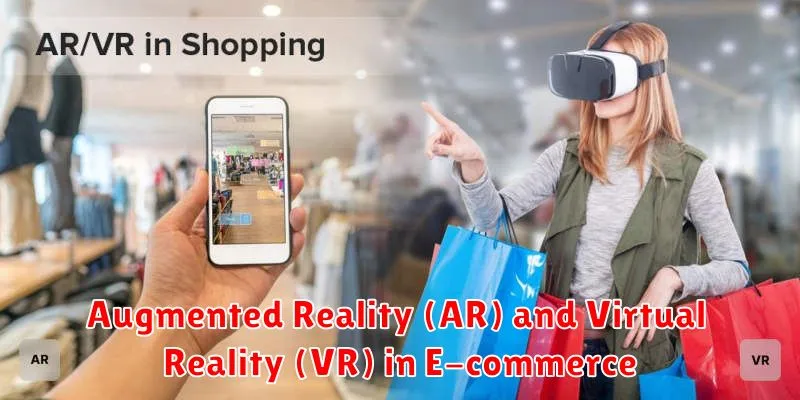
In the ever-evolving landscape of e-commerce, staying ahead of the curve is paramount. Among the latest technological trends shaping the industry, augmented reality (AR) and virtual reality (VR) are emerging as game-changers.
AR overlays digital information onto the real world, enhancing user experiences. In e-commerce, AR allows customers to visualize products in their own environment. For example, furniture retailers can use AR to let customers see how a sofa would look in their living room before purchasing. This immersive experience can significantly reduce purchase anxiety and increase confidence in online purchases.
VR, on the other hand, creates fully immersive virtual environments. This technology is particularly powerful for showcasing products that are difficult to experience online, such as clothing, jewelry, or cosmetics. Imagine trying on a new dress in a virtual fitting room or exploring a virtual showroom to discover new furniture pieces. VR can elevate the online shopping experience to unprecedented levels of engagement.
The adoption of AR and VR in e-commerce is still in its early stages, but the potential benefits are undeniable. By providing immersive and interactive experiences, these technologies can:
- Enhance customer engagement
- Reduce product returns
- Boost conversion rates
- Create a competitive advantage
As AR and VR continue to evolve, we can expect even more innovative applications in e-commerce. These technologies are poised to revolutionize the way we shop online, creating a more engaging, personalized, and satisfying experience for customers.
Voice Search and Conversational Commerce

The e-commerce landscape is constantly evolving, and staying ahead of the curve is crucial for businesses to thrive. One of the most exciting and transformative trends is the rise of voice search and conversational commerce. This technology allows customers to interact with businesses using natural language, creating a seamless and personalized shopping experience.
Voice search empowers consumers to find products and services simply by speaking their requests. As voice assistants like Siri, Alexa, and Google Assistant become increasingly sophisticated, consumers are adopting this technology for their daily tasks, including shopping.
Conversational commerce takes the interaction a step further, enabling customers to engage in natural conversations with businesses through chatbots, messaging apps, and other platforms. These conversations can help customers find products, get answers to questions, and complete transactions without ever leaving their preferred communication channel.
By embracing voice search and conversational commerce, businesses can:
- Enhance customer experience by providing a more natural and convenient way to shop.
- Increase discoverability and reach a wider audience through voice search optimization.
- Improve efficiency by automating routine tasks and providing instant answers to customer queries.
- Gather valuable insights through conversational data, allowing for targeted marketing and product development.
The future of e-commerce is conversational, and businesses that adapt to this trend will be well-positioned for success. By investing in voice search optimization and implementing conversational commerce solutions, businesses can create a truly personalized and engaging shopping experience for their customers.
Headless Commerce and API-driven Architectures
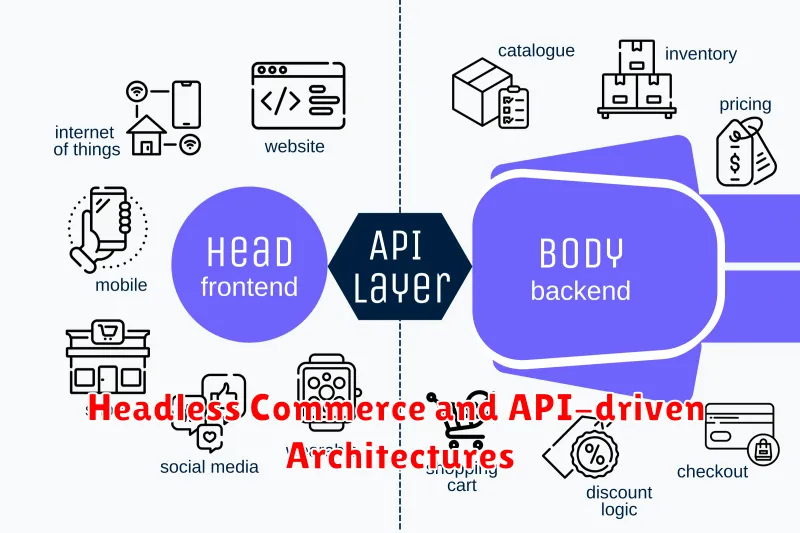
In the dynamic realm of e-commerce, staying ahead of the curve is paramount. Businesses are constantly seeking innovative solutions to enhance customer experiences, streamline operations, and achieve sustainable growth. Among the latest trends shaping the e-commerce landscape, headless commerce and API-driven architectures are gaining significant traction.
Headless commerce, as the name suggests, separates the front-end (the customer-facing interface) from the back-end (the commerce logic and data). This decoupling empowers businesses to choose the best-suited front-end technologies, be it a website, mobile app, voice assistant, or any other emerging channel. The back-end, on the other hand, can be accessed through APIs (Application Programming Interfaces), enabling seamless integration with various third-party applications and services.
API-driven architectures are at the heart of headless commerce, enabling seamless data exchange and process orchestration across different systems. These APIs provide a standardized way for different components to communicate, facilitating agility, scalability, and customization. By leveraging APIs, businesses can unlock a wealth of possibilities, from personalized recommendations and dynamic pricing to advanced analytics and omnichannel experiences.
The benefits of headless commerce and API-driven architectures are manifold. Businesses can achieve greater flexibility, faster time-to-market, improved scalability, and enhanced customer experiences. By decoupling the front-end and back-end, businesses can adapt to rapidly evolving customer expectations and market trends without compromising core functionalities. Furthermore, APIs empower businesses to connect with a vast ecosystem of best-of-breed solutions, tailoring their e-commerce platform to meet specific needs and objectives.
As e-commerce continues to evolve, headless commerce and API-driven architectures are poised to become indispensable tools for businesses seeking to thrive in the digital age. By embracing these technologies, businesses can unlock new possibilities, optimize operations, and create truly exceptional customer experiences.
Cybersecurity and Data Privacy in E-commerce
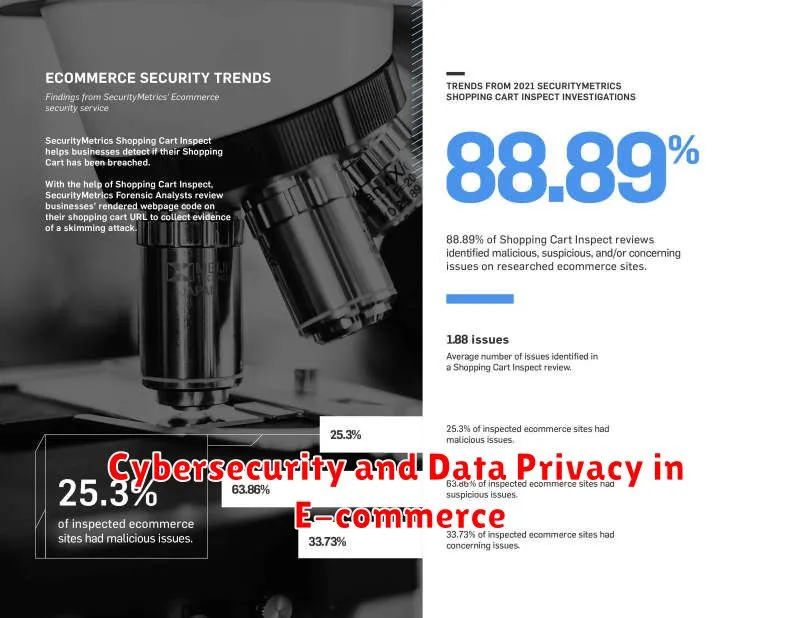
The digital landscape is constantly evolving, presenting both exciting opportunities and pressing challenges for e-commerce businesses. As online shopping continues to grow, securing sensitive customer data and protecting against cyber threats becomes increasingly crucial. In this dynamic environment, cybersecurity and data privacy are not just compliance requirements but essential components of a successful e-commerce strategy.
Consumers are increasingly aware of the importance of data privacy, and they demand transparency and control over their information. E-commerce businesses must implement robust security measures, including strong encryption, multi-factor authentication, and regular security audits, to build trust with their customers. These measures help safeguard sensitive data such as financial information, personal details, and purchase history from unauthorized access and malicious attacks.
Beyond data protection, cybersecurity plays a crucial role in ensuring business continuity and preventing financial losses. E-commerce platforms are prime targets for cybercriminals, with attacks ranging from phishing scams and malware infections to distributed denial of service (DDoS) attacks. Implementing advanced security solutions, including firewalls, intrusion detection systems, and threat intelligence platforms, is essential for proactive defense against these threats.
In conclusion, cybersecurity and data privacy are fundamental pillars of a successful e-commerce strategy. By prioritizing these areas, businesses can cultivate customer trust, protect their valuable assets, and thrive in the ever-evolving digital marketplace. Staying ahead of the curve requires a commitment to continuous improvement, adopting innovative security technologies, and maintaining a vigilant approach to risk management.
The Future of E-commerce: Predictions and Opportunities
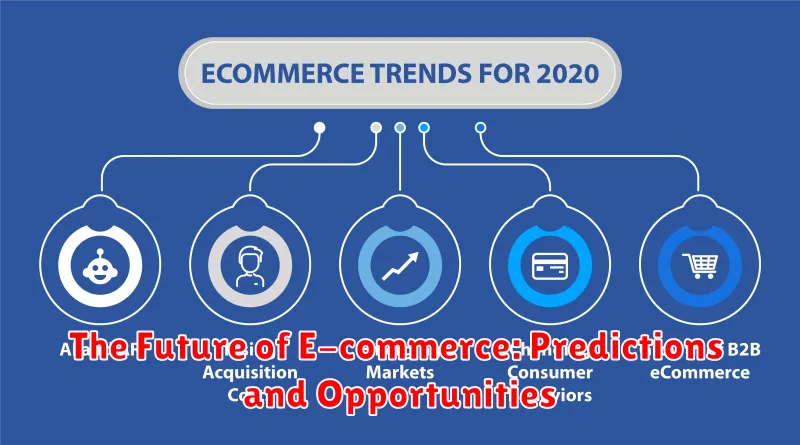
E-commerce has transformed the way we shop, and its evolution shows no signs of slowing down. As technology continues to advance, we can expect even more innovative and exciting developments in the world of online retail. Here are some key predictions and opportunities that will shape the future of e-commerce:
Personalization: E-commerce will become increasingly personalized, offering shoppers a tailored experience based on their preferences, browsing history, and purchase behavior. This will be powered by advancements in artificial intelligence (AI) and machine learning (ML). AI-powered recommendations will provide shoppers with relevant product suggestions, improving their chances of finding what they need and increasing conversion rates.
Augmented Reality (AR) and Virtual Reality (VR): AR and VR technologies will revolutionize the online shopping experience. AR allows customers to visualize products in their own space before purchasing, while VR provides immersive shopping environments that allow customers to “try on” clothes, explore virtual stores, and interact with products in a more engaging way.
The Rise of Voice Commerce: Voice assistants like Amazon Alexa and Google Assistant are becoming increasingly popular, making it easier than ever to shop using voice commands. This trend is expected to continue, leading to a surge in voice-based shopping experiences. Expect seamless integration with e-commerce platforms, enabling customers to order products by voice without ever having to open a browser or app.
Sustainable E-commerce: Consumers are increasingly concerned about environmental sustainability. E-commerce businesses will need to adapt by adopting eco-friendly practices, such as using sustainable packaging, reducing carbon footprints, and offering ethical products. Businesses that prioritize sustainability will gain a competitive edge in the long run.
The Metaverse: The metaverse is a virtual world where people can interact with each other and digital environments. This emerging technology has the potential to revolutionize online shopping by creating a more immersive and engaging experience for customers. Imagine shopping in virtual stores, interacting with virtual products, and trying on clothes in a virtual fitting room, all within the metaverse.
Mobile-First Experience: Mobile shopping will continue to dominate. E-commerce businesses need to ensure their websites and apps are optimized for mobile devices. This includes fast loading times, intuitive navigation, and responsive design.
The future of e-commerce is brimming with exciting possibilities. By embracing these trends, businesses can stay ahead of the curve, enhance customer experiences, and achieve greater success in the ever-evolving digital landscape.

